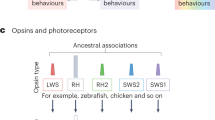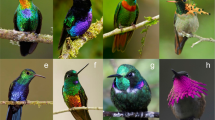Abstract
Humans are colour-blind at night, and it has been assumed that this is true of all animals. But colour vision is as useful for discriminating objects1 at night as it is during the day. Here we show, through behavioural experiments, that the nocturnal hawkmoth Deilephila elpenor uses colour vision to discriminate coloured stimuli at intensities corresponding to dim starlight (0.0001 cd m-2). It can do this even if the illumination colour changes, thereby showing colour constancy—a property of true colour vision systems2. In identical conditions humans are completely colour-blind. Our calculations show that the possession of three photoreceptor classes reduces the absolute sensitivity of the eye, which indicates that colour vision has a high ecological relevance in nocturnal moths. In addition, the photoreceptors of a single ommatidium absorb too few photons for reliable discrimination, indicating that spatial and/or temporal summation must occur for colour vision to be possible. Taken together, our results show that colour vision occurs at nocturnal intensities in a biologically relevant context.
This is a preview of subscription content, access via your institution
Access options
Subscribe to this journal
Receive 51 print issues and online access
$199.00 per year
only $3.90 per issue
Buy this article
- Purchase on Springer Link
- Instant access to full article PDF
Prices may be subject to local taxes which are calculated during checkout




Similar content being viewed by others
References
Kelber, A., Vorobyev, M. & Osorio, D. Animal colour vision—behavioural tests and physiological concepts. Biol. Rev. (in the press)
Neumeyer, C. Perceptual Constancy: Why Things Look as They Do (eds Walsh, V. & Kulikowski, J.) 323–351 (Cambridge Univ. Press, Cambridge, 1998)
Höglund, G., Hamdorf, K. & Rosner, G. Trichromatic visual system in an insect and its sensitivity control by blue light. J. Comp. Physiol. 86, 265–279 (1973)
Schwemer, J. & Paulsen, R. Three visual pigments in Deilephila elpenor (Lepidoptera, Sphingidae). J. Comp. Physiol. 86, 215–229 (1973)
Schlecht, P. Colour discrimination in dim light. An analysis of the photoreceptor arrangement in the moth Deilephila. J. Comp. Physiol. 129, 257–267 (1979)
Pittaway, A. R. The Hawkmoths of the Western Palaearctic (Harley Books, Colchester, 1993)
Vogel, S. Blütenbiologische Typen als Elemente der Sippengliederung (G. Fischer, Jena, 1954)
White, R. H., Stevenson, R. D., Bennett, R. R., Cutler, D. E. & Haber, W. A. Wavelength discrimination and the role of ultraviolet vision in the feeding behaviour of hawkmoths. Biotropica 26, 427–435 (1994)
Raguso, R. A. & Willis, M. A. Proceedings of the Third International Symposium on Butterfly Ecology and Evolution (eds Watt, W. B., Boggs, C. & Ehrlich, P. R.) (Univ. of Chicago Press, Chicago, in the press)
Kelber, A. & Hénique, U. Trichromatic colour vision in the hummingbird hawkmoth, Macroglossum stellatarum. J. Comp. Physiol. A 184, 535–541 (1999)
Knoll, F. Lichtsinn und Blütenbesuch des Falters von Deilephila livornica. Z. vergl. Physiol. 2, 328–380 (1926)
Frisch, K. von Der Farbensinn und Formensinn der Biene. Zool. Jb. Abt. Allg. Zool. Physiol. 35, 1–188 (1914)
Minnaert, M. G. J. Light and Color in the Outdoors (Springer, New York, 1993)
Land, M. F. Handbook of Sensory Physiology (ed. Autrum, H.) Vol. VII/6B 471–592 (Springer, Berlin, 1981)
Rose, A. The relative sensitivities of television pickup tubes, photographic film and the human eye. Proc. Inst. Radio Eng. NY 30, 293–300 (1942)
De Vries, H. The quantum character of light and its bearing upon threshold of vision, the differential sensitivity and visual acuity of the eye. Physica 10, 553–564 (1943)
Warrant, E., Porombka, T. & Kirchner, W. H. Neural image enhancement allows honeybees to see at night. Proc. R. Soc. Lond. B 263, 1521–1526 (1996)
Warrant, E. J. Seeing better at night: life-style, eye design and the optimum strategy of spatial and temporal summation. Vision Res. 39, 1611–1630 (1999)
Menzel, R. Achromatic vision in the honeybee at low light intensities. J. Comp. Physiol. A 141, 389–393 (1981)
Powers, M. K. & Easter, S. S. Wavelength discrimination by the goldfish near absolute visual threshold. Vision Res. 18, 1149–1154 (1978)
Welsch, B. Ultrastruktur und funktionelle Morphologie der Augen des Nachtfalters Deilephila elpenor (Lepidoptera, Sphingidae). Cytobiologie 14, 378–400 (1977)
Warrant, E. J. & Nilsson, D.-E. Absorption of white light in photoreceptors. Vision Res. 38, 195–207 (1998)
Warrant, E. J. & McIntyre, P. D. Screening pigment, aperture and sensitivity in the dung beetle superposition eye. J. Comp. Physiol. A 167, 804–816 (1990)
Stavenga, D. G., Smits, R. P. & Hoenders, B. J. Simple exponential functions describing the absorbance bands of visual pigment spectra. Vision Res. 33, 1011–1017 (1993)
Acknowledgements
We thank D.-E. Nilsson for critically reading the manuscript; M. Pfaff for insights into hawkmoth behaviour; the human volunteers for participating in experiments; and everybody in the Vision Group for inspiration. We are grateful for the financial support of the Swedish Research Council.
Author information
Authors and Affiliations
Corresponding author
Ethics declarations
Competing interests
The authors declare that they have no competing financial interests.
Rights and permissions
About this article
Cite this article
Kelber, A., Balkenius, A. & Warrant, E. Scotopic colour vision in nocturnal hawkmoths. Nature 419, 922–925 (2002). https://doi.org/10.1038/nature01065
Received:
Accepted:
Issue Date:
DOI: https://doi.org/10.1038/nature01065
This article is cited by
-
The Flower Colour Influences Spontaneous Nectaring in Butterflies: a Case Study with Twenty Subtropical Butterflies
Neotropical Entomology (2023)
-
Knockout of the LW opsin gene interferes with oviposition selection of nocturnal moth, Helicoverpa armigera
Journal of Pest Science (2023)
-
Reaction of Imagos of the Adzuki Bean Borer Ostrinia Scapulalis to Light Stimuli in a Wind Tunnel
Neuroscience and Behavioral Physiology (2023)
-
Vision in dim light and the evolution of color pattern in a crepuscular/nocturnal frog
Evolutionary Ecology (2022)
-
Artificial nighttime lighting impacts visual ecology links between flowers, pollinators and predators
Nature Communications (2021)
Comments
By submitting a comment you agree to abide by our Terms and Community Guidelines. If you find something abusive or that does not comply with our terms or guidelines please flag it as inappropriate.



